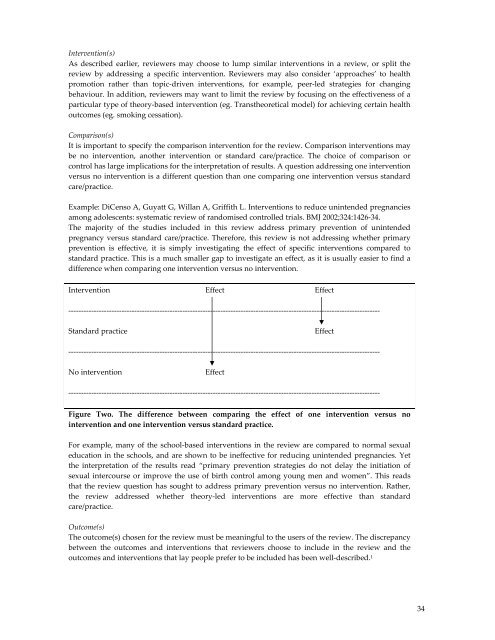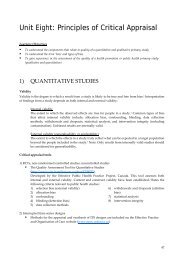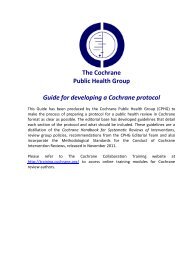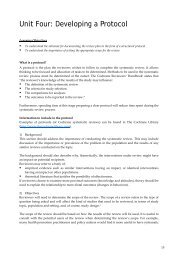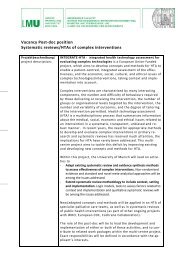Train the Trainer Course book - Cochrane Public Health Group
Train the Trainer Course book - Cochrane Public Health Group
Train the Trainer Course book - Cochrane Public Health Group
Create successful ePaper yourself
Turn your PDF publications into a flip-book with our unique Google optimized e-Paper software.
Intervention(s)<br />
As described earlier, reviewers may choose to lump similar interventions in a review, or split <strong>the</strong><br />
review by addressing a specific intervention. Reviewers may also consider ‘approaches’ to health<br />
promotion ra<strong>the</strong>r than topic-driven interventions, for example, peer-led strategies for changing<br />
behaviour. In addition, reviewers may want to limit <strong>the</strong> review by focusing on <strong>the</strong> effectiveness of a<br />
particular type of <strong>the</strong>ory-based intervention (eg. Trans<strong>the</strong>oretical model) for achieving certain health<br />
outcomes (eg. smoking cessation).<br />
Comparison(s)<br />
It is important to specify <strong>the</strong> comparison intervention for <strong>the</strong> review. Comparison interventions may<br />
be no intervention, ano<strong>the</strong>r intervention or standard care/practice. The choice of comparison or<br />
control has large implications for <strong>the</strong> interpretation of results. A question addressing one intervention<br />
versus no intervention is a different question than one comparing one intervention versus standard<br />
care/practice.<br />
Example: DiCenso A, Guyatt G, Willan A, Griffith L. Interventions to reduce unintended pregnancies<br />
among adolescents: systematic review of randomised controlled trials. BMJ 2002;324:1426-34.<br />
The majority of <strong>the</strong> studies included in this review address primary prevention of unintended<br />
pregnancy versus standard care/practice. Therefore, this review is not addressing whe<strong>the</strong>r primary<br />
prevention is effective, it is simply investigating <strong>the</strong> effect of specific interventions compared to<br />
standard practice. This is a much smaller gap to investigate an effect, as it is usually easier to find a<br />
difference when comparing one intervention versus no intervention.<br />
Intervention Effect Effect<br />
---------------------------------------------------------------------------------------------------------------------------<br />
Standard practice<br />
Effect<br />
---------------------------------------------------------------------------------------------------------------------------<br />
No intervention<br />
Effect<br />
---------------------------------------------------------------------------------------------------------------------------<br />
Figure Two. The difference between comparing <strong>the</strong> effect of one intervention versus no<br />
intervention and one intervention versus standard practice.<br />
For example, many of <strong>the</strong> school-based interventions in <strong>the</strong> review are compared to normal sexual<br />
education in <strong>the</strong> schools, and are shown to be ineffective for reducing unintended pregnancies. Yet<br />
<strong>the</strong> interpretation of <strong>the</strong> results read “primary prevention strategies do not delay <strong>the</strong> initiation of<br />
sexual intercourse or improve <strong>the</strong> use of birth control among young men and women”. This reads<br />
that <strong>the</strong> review question has sought to address primary prevention versus no intervention. Ra<strong>the</strong>r,<br />
<strong>the</strong> review addressed whe<strong>the</strong>r <strong>the</strong>ory-led interventions are more effective than standard<br />
care/practice.<br />
Outcome(s)<br />
The outcome(s) chosen for <strong>the</strong> review must be meaningful to <strong>the</strong> users of <strong>the</strong> review. The discrepancy<br />
between <strong>the</strong> outcomes and interventions that reviewers choose to include in <strong>the</strong> review and <strong>the</strong><br />
outcomes and interventions that lay people prefer to be included has been well-described. 1<br />
34


